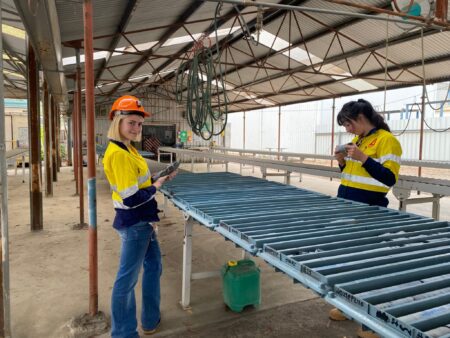
Careers Corner
Work Experience
At SCEGGS, we recognise the value of work experience to allow students to explore potential career paths, develop practical capabilities, and gain insight into the world of work. Moreover, work experience helps the girls to make connections between school subjects, career research and real-life situations. Year 11’s Pippa Brenner shares her insights from her recent work experience as a geologist – we hope you enjoy it!

Over the Term 3 holidays, I travelled to Cobar in rural NSW to complete work experience as a geologist with Aurelia Metals. Over three days, I visited several mine sites to understand how modern mining operations work, the importance of sustainability, and the vital role geologists play in managing resources responsibly.
On my first day, I toured Federation Mine, a high-grade zinc, lead, gold, copper, and silver deposit. There, I learnt how geologists map and analyse the earth using traditional hand-drawn maps alongside advanced CAD software and 3D scanning technologies. Seeing how data translates into real-world mining plans showed me how essential geology is in both exploration and environmental management. The second day began early at Peak Mine, one of Aurelia’s most successful operations. I joined the daily geology meeting and saw how the mine runs 24 hours a day through precise planning and teamwork. Later, I visited Fort Bourke, where exploration geologists showed me active drill sites and explained how they determine viable exploration zones. What stood out most was Aurelia’s commitment to Indigenous relations, working closely with Traditional Owners to ensure mining does not disturb sacred land or natural ecosystems.
The company also partners with local Indigenous communities to provide employment, training, and long-term opportunities, fostering strong and respectful relationships. At Kairos Deep, one of Peak Mine’s newest discoveries, I learnt how drill rigs operate and how vital safety and environmental checks are before any operation begins. My supervisors, Dinesh and Susie, explained that mining plays a crucial role in Australia’s transition to a low-carbon future. The minerals extracted, including copper, zinc, and rare earth elements, are essential for renewable technologies such as solar panels, electric vehicles, and wind turbines.
Mining, when done responsibly, supports global decarbonisation efforts and drives innovation in sustainable resource use. At Peak, I also learned how rehabilitation is essential in the mining process. Sustainability measures are taken at every stage to ensure the environment remains as undamaged as possible. When a mine is completed, great care is taken to restore the area to its natural state by reintroducing native flora and fauna, filling in mining voids, and removing any remaining equipment or waste. I visited a rehabilitated site near Peak and was amazed by how untouched it appeared. The landscape was vibrant and full of life, with greenery and wildlife thriving, showing how effective these rehabilitation efforts can be. On my final day at Hera Mine, I visited the core lab, where samples are analysed for valuable minerals such as gold. I was able to conduct my own analysis, marking core samples and identifying mineralisation.
This experience deepened my understanding of geology’s precision and purpose. Through this experience, I gained a new appreciation for geology’s role in building a sustainable and ethical mining future. I also recognised the need for greater female representation in the industry. Mining remains largely male-dominated, yet the inclusion of women’s perspectives and ideas is essential to drive progress, innovation, and environmental responsibility. My time in Cobar reinforced my passion for geology and showed me how it can shape a cleaner, fairer, and more sustainable future.
Careers Corner
Please click here to read this week’s Careers Corner Newsletter.
Andrea Pinnock
Careers Advisor


